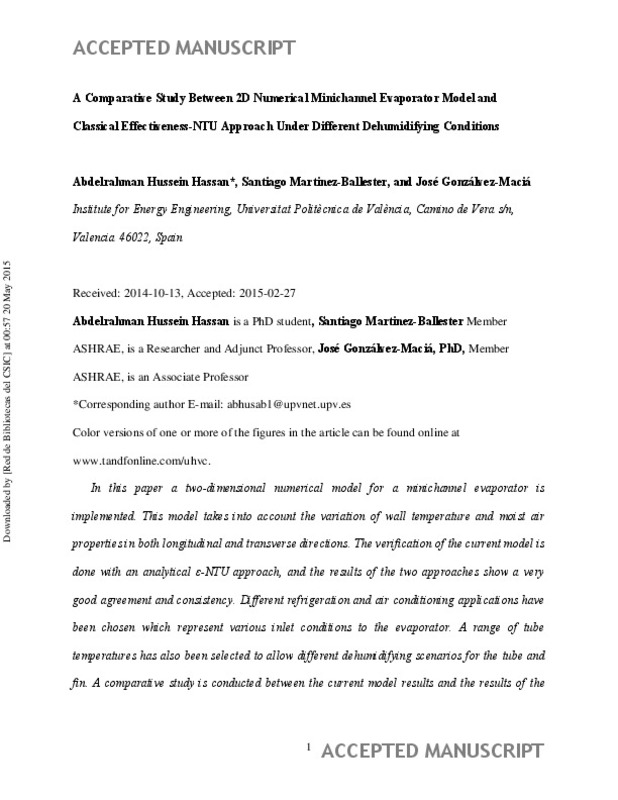JavaScript is disabled for your browser. Some features of this site may not work without it.
Buscar en RiuNet
Listar
Mi cuenta
Estadísticas
Ayuda RiuNet
Admin. UPV
A comparative study between a two-dimensional numerical minichannel evaporator model and a classical effectiveness-NTU approach under different dehumidifying conditions
Mostrar el registro sencillo del ítem
Ficheros en el ítem
| dc.contributor.author | Hassan, Abdelrahman Hussein Abdelhalim
|
es_ES |
| dc.contributor.author | Martínez Ballester, Santiago
|
es_ES |
| dc.contributor.author | Gonzálvez Maciá, José
|
es_ES |
| dc.date.accessioned | 2017-05-26T07:16:44Z | |
| dc.date.available | 2017-05-26T07:16:44Z | |
| dc.date.issued | 2015-07-04 | |
| dc.identifier.issn | 2374-4731 | |
| dc.identifier.uri | http://hdl.handle.net/10251/81802 | |
| dc.description.abstract | In this article, a two-dimensional numerical model for a minichannel evaporator is implemented. This model takes into account the variation of wall temperature and moist air properties in both longitudinal and transverse directions. The verification of the current model is done with an analytical effectiveness number of transfer units (ε NTU) approach, and the results of the two approaches show very good agreement and consistency. Different refrigeration and air-conditioning applications have been chosen that represent various inlet conditions to the evaporator. A range of tube temperatures has also been selected to allow different dehumidifying scenarios for the tube and fin. A comparative study is conducted between the current model results and the results of the traditional ε NTU method based on two different models of simultaneous heat and mass transfer. Significant deviations in results between the current model and the traditional ε NTU approach are found, especially in latent heat transfer. These deviations are mainly due to the assumptions that are normally adopted by the ε NTU method and fin theory, such as no variation in moist air temperature and humidity ratio along the direction between tubes, no accounting for partially wet fin conditions, and finally, the assumption of a constant average saturation line slope within a specific evaporator segment. | es_ES |
| dc.description.sponsorship | Author Hassan is partially supported by the Santiago Grisolia 2012 Program, which is funded by the Valencian Community (reference number GRISOLIA/2012/005). Financial support from the Spanish Ministry of Economy and Finance is also gratefully acknowledged (project numbers DPI2011-26771-C02-01). | en_EN |
| dc.language | Inglés | es_ES |
| dc.publisher | Taylor & Francis | es_ES |
| dc.relation.ispartof | Science and Technology for the Built Environment | es_ES |
| dc.rights | Reserva de todos los derechos | es_ES |
| dc.subject | Minichannel evaporator | es_ES |
| dc.subject | Numerical modeling | es_ES |
| dc.subject | Air-side analysis, heat transfer, mass transfer | es_ES |
| dc.subject.classification | MAQUINAS Y MOTORES TERMICOS | es_ES |
| dc.title | A comparative study between a two-dimensional numerical minichannel evaporator model and a classical effectiveness-NTU approach under different dehumidifying conditions | es_ES |
| dc.type | Artículo | es_ES |
| dc.identifier.doi | 10.1080/23744731.2015.1028866 | |
| dc.relation.projectID | info:eu-repo/grantAgreement/GVA//GRISOLIA%2F2012%2F005/ | es_ES |
| dc.relation.projectID | info:eu-repo/grantAgreement/MICINN//DPI2011-26771-C02-01/ES/ESTUDIO DE EVAPORADORES Y CONDENSADORES BASADOS EN TECNOLOGIA DE MINICANALES PARA SU APLICACION EN EQUIPOS DE AIRE ACONDICIONADO, REFRIGERACION Y BOMBA DE CALOR ESTACIONARIOS/ | es_ES |
| dc.rights.accessRights | Abierto | es_ES |
| dc.contributor.affiliation | Universitat Politècnica de València. Escuela Técnica Superior de Ingenieros Industriales - Escola Tècnica Superior d'Enginyers Industrials | es_ES |
| dc.contributor.affiliation | Universitat Politècnica de València. Instituto de Ingeniería Energética - Institut d'Enginyeria Energètica | es_ES |
| dc.description.bibliographicCitation | Hassan, AHA.; Martínez Ballester, S.; Gonzálvez Maciá, J. (2015). A comparative study between a two-dimensional numerical minichannel evaporator model and a classical effectiveness-NTU approach under different dehumidifying conditions. Science and Technology for the Built Environment. 21(5):681-692. https://doi.org/10.1080/23744731.2015.1028866 | es_ES |
| dc.description.accrualMethod | S | es_ES |
| dc.relation.publisherversion | http://doi.org/10.1080/23744731.2015.1028866 | es_ES |
| dc.description.upvformatpinicio | 681 | es_ES |
| dc.description.upvformatpfin | 692 | es_ES |
| dc.type.version | info:eu-repo/semantics/publishedVersion | es_ES |
| dc.description.volume | 21 | es_ES |
| dc.description.issue | 5 | es_ES |
| dc.relation.senia | 293552 | es_ES |
| dc.identifier.eissn | 2374-474X | |
| dc.contributor.funder | Generalitat Valenciana | es_ES |
| dc.contributor.funder | Ministerio de Ciencia e Innovación | es_ES |






![[Cerrado]](/themes/UPV/images/candado.png)


